Did you know that dividing words into syllables is one of the most powerful decoding strategies out there?
If your students are ready to read words with more than one syllable, then it’s time to start teaching syllable division rules!
When readers know the syllable division rules, it A) helps them successfully decode multisyllabic words and B) provides them with clues about the vowel sounds in multisyllabic words!
Knowing how to divide words into syllables gives your kids POWER to attack those longer words!
In today’s post, I’ll explain how to teach students to divide words into syllables!
…And I also have something to confess:
Despite being an English speaker, teacher, and avid reader, I did not know these rules until I’d already been teaching for years.
So if these rules are new to you, don’t sweat it! We’re all learning! All the time!
The 6 Syllable Types
Do you know the 6 syllable types? They are:
- Closed
- Open
- Vowel-Consonant-E (also known as Magic E or Silent E)
- Vowel Team
- R-Controlled
- Consonant-L-E
If you haven’t read my post that goes in-depth on these syllable types, you may want to read that first, and then come back to this post. My 6 syllable types post can be found HERE!
(And yes – there are a lot of terms and rules to remember when you’re teaching phonics. If you’d like a free PDF that has many different terms and rules in one place, grab this freebie!)
Finding the Number of Syllables in a Word
An important first step in dividing up a word into its syllables is knowing how many syllables the word has.
You may already know that 1 vowel sound = 1 syllable. If a word has 3 vowel sounds, for example, then it has 3 syllables.
(Notice that I’m saying vowel sounds, not actual vowels. The word “cupcake,” for example, technically has 3 vowels. But the e is silent. It only has two syllables because the vowel sounds we hear are the short u and the long a, 2 total vowel sounds.)
Syllable Division Patterns
There are only 6 syllable types, and there are even fewer syllable division patterns!
The syllable division patterns are as follows (V = vowel; C = consonant):
VC/CV
If you have two consonant sounds between two vowel sounds, divide the word between the consonant sounds.
In the word “sunset,” the vowel sounds are the short u and the short e. The two consonants in the middle, n and s, get divided up.
In the word “bathtub,” the vowel sounds are the short a and the short u. The two consonant SOUNDS in the middle are /th/ and /t/. The word gets divided up between the h and the second t.
If there are 3 consonants between the vowels, rather than 2, there’s going to be a blend in there. The sounds that get blended together stay together in one syllable.
For example, in the word “complex,” we divide between the m and the p.
V/CV
Moving on…sometimes there’s just one consonant sound between the vowels, rather than 2.
If this is the case, the first syllable division rule that we try is V/CV (dividing up the word BEFORE the consonant).
For example, in the word “robot,” we divide up the word before the b. This creates an open syllable, “ro,” that ends in a vowel. As a result, the o in that syllable is a long o.
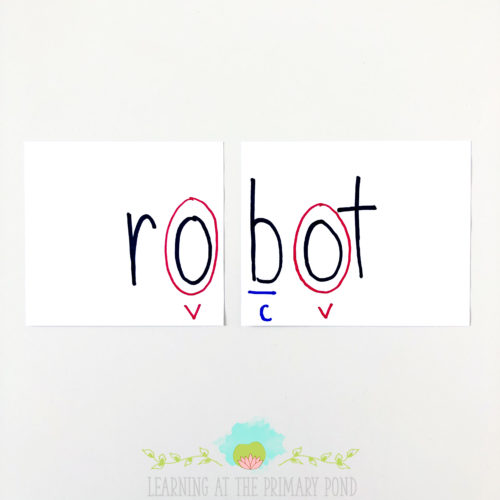
VC/V
However, sometimes the V/CV division rule doesn’t work. This is where it gets a little tricky.
If we try the V/CV rule but discover that it creates an open first syllable that should NOT be open (aka it should not have a long vowel sound), then we have to revert to the VC/V pattern.
For example, let’s think about the word “comet.” It’s pronounced with a short o at the beginning, right? It’s not CO-met. But if we were to apply the V/CV division pattern, that would make the o sound long. Instead, we have to revert to VC/V in order to reflect the fact that the o has the short o sound.

Another example is the word “seven:”
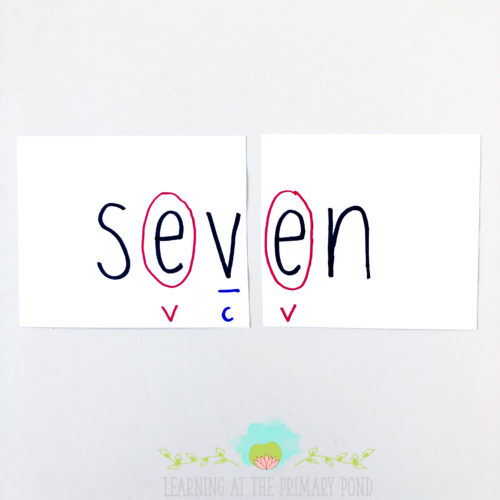
V/V
Last but not least, we have the V/V syllable division rule! When there are two vowels next to each other that do NOT work as a team, then we divide the word between those two separate vowel sounds.
For example, we divide the word “diet” between the i and the e:

However, in a word like “coat,” we do NOT divide between the o and the a. There is only one vowel sound, the long o. Therefore, it’s a one-syllable word, and the o and the a work together to make a single sound. They cannot be divided up.
Tips for Teaching Syllable Division Rules to Students
Okay, so….that’s not too bad, right? Once you understand the four syllable division patterns, then you can teach them to your students!
As you probably noticed from the photos in this post, I have my students circle and label the vowels with red, underline and label the consonants with blue, and then cut or draw a line to divide the words. (Scroll back up through the photos in this post and have a closer look at what I did, if that helps.)
Here’s the procedure:
- Look at the word. Circle the vowel sounds with red.
- Underline the consonants BETWEEN the vowels (don’t worry about the other consonants).
- Determine which syllable division rule (VC/CV, V/CV, VC/V, or V/V) applies. (Students may have to attempt to read the word to choose between V/CV and VC/V.)
- Cut or mark the word accordingly.
- Read the word.
You can also have students code the syllable types after Step #3 (closed, open, VCE, vowel team, r-controlled, or CLE—read more about the syllable types HERE!)
When we’re learning about syllable division and syllable types, we use strips of paper. Students can copy a word I write on the board (or I prepare the word strips for them ahead of time).
I don’t read the word to them, because the purpose of the division exercise is to get them to break up the word and read it.
Once they’ve copied the word, then we go through Steps 1-5 listed above, and students can cut the word in half.
The ultimate goal of this exercise is to get students to break up multisyllabic words as they read. So, as a bridge between this activity and reading, we use whiteboards or sticky notes to divide up tricky words they encounter in texts.
If I’m working one-on-one with a student and he/she comes to a tricky word, we can write it on a small whiteboard and then break it up.
If students are working on their own, they can write a tricky word on a sticky note, divide it up, read it, and then continue reading.
This does slow down the reading process a little, but I’m telling you…kids feel SO powerful when they can break up words and determine what types of syllables they have. This process also makes it easier for students to figure out the vowel sounds in a word too.
When to Teach This Stuff
You might be wondering, “When should I teach these rules? At what developmental stage or grade level are these appropriate?”
When to teach the VC/CV rule:
Whenever kids have mastered CVC words, they can read 2-syllable words!
Simple compound words are a great place to start. You’ll want to use words like “sunset” and “pigpen” that are 2 CVC words “put together.” At this point, you can teach students the VC/CV rule. You can also explain that both of the syllables in those words are closed and have short vowels.
I don’t normally teach this in Kindergarten, but if I have more advanced students who are truly proficient with CVC words, then it makes sense to give them “access” to these simple 2-syllable words.
Of course, if you give students words with consonant digraphs or blends in between, then it becomes a little more complicated—early first grade may be a better time for those more complicated VC/CV words.
When to teach the V/CV and VC/V rules:
I teach the V/CV rule first, because we always try the V/CV pattern before reverting to VC/V.
You can teach this rule once students know about the long vowel sounds.
They don’t need to have completely mastered long vowels and all their spelling patterns. But they at least need to understand the concepts of open and closed syllables (and how short and long vowels relate to open and closed syllables).
When we’re working on the V/CV rule, I intentionally only give them practice words that follow that rule.
After they understand the V/CV rule, then I explain that sometimes we have to use the VC/V rule instead.
I then give them VC/V words to practice.
Finally, I give them mixed sets of words where they have to choose between V/CV and VC/V.
When to teach the V/V rules:
I wait to teach V/V until students really understand vowel teams and diphthongs.
If students don’t understand vowel teams, then they may try to divide up words like “train” into two syllables, between the a and the i. If they don’t understand diphthongs, they may try to divide up words like “loud” into two syllables.
Once they know the vowel teams and diphthongs, however, they’re more likely to recognize that words like “fluent” have two vowel sounds, not one, and we divide up the word accordingly (flu/ent).
Conclusions
This was a lot of info, right?! And it’s a lot to figure out and teach on your own – if you don’t have lesson plans and materials for it. Because unfortunately, many phonics and reading programs don’t cover this stuff!
If you’d like to make teaching this EASY and FUN for you and your students, check out my step-by-step guide to teaching all the syllable division rules and syllable types.
I designed this resource to fit perfectly into any phonics program. (However, if you’re using my phonics program, From Sounds to Spelling, you won’t need this resource because we cover this info within the program.)
You set the pace for how quickly you progress through these lessons! 1st grade teachers may spread them out throughout the entire school year, while 2nd grade and up may progress more quickly. Here’s page 1 of the table of contents (this is only half of the lessons):
Here’s what a lesson plan looks like:
Also included are words to practice dividing, plus lots of hands-on games!
Everything is done for you, so you won’t have to invest time or energy in figuring all this out on your own and creating lessons!
However, if you already feel confident in teaching syllable division and have plenty of materials for it, you may just need a few practice activities for your students. If that’s the case, my digital practice games might be a better fit.
These activities give your students practice with dividing words up into syllables AND identifying syllable types. The games include audio directions that explain the syllable types and division rules!


I hope these resources are helpful to you! You can also pin this blog post to your Pinterest account so you can come back to it later:

Happy teaching!


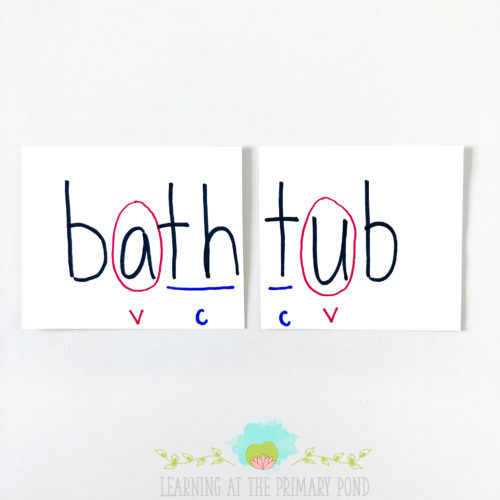






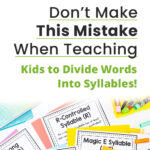




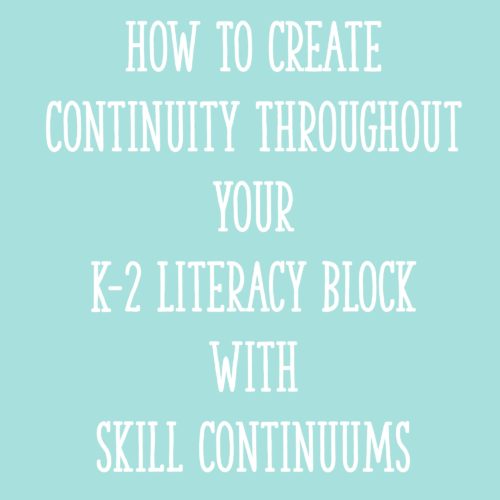






This is a fantastic blog post. I knew about these syllable patterns but wasn’t confident in how to teach my first graders about them. This has helped. I am looking forward to the webinar.
Do you have words and/or activities we can use with our students? I have a group ready to learn this now. Thanks!
Hi Deb! I don’t have anything available right now, but in about 2 weeks, I’ll be releasing some digital word work bundles that will include syllabication activities. 🙂
Alison
I was going to ask this as well. I will be interested to see this when you have it out!
Do you have any lesson plans in TpT for teaching this? I can’t wait for your webinar.
Hi Cindy! I have a couple of lesson plans with the basics, but they’re part of my shared reading series (which focuses on much much more than just syllables): https://www.teacherspayteachers.com/Store/Learning-At-The-Primary-Pond-Alison/Category/Shared-Reading-336174
Alison
HEY DEAR, your post is amazing! but the only problem i found is with the example you have given ie. Diet. here ie is a long vowel (i) sound. so its a single syllable word. so we cannot divide it between i and e. its a single sound that is long vowel ‘i’ sound. And so is a single syllable word. like your other example ‘coat’ here its ‘oa’ is a long vowel ‘o’ sound so we cannot divide it between ‘o’ and ‘a’ and says it a single syllable word. may be i’m wrong but if i am then… Read more »
Hey! The difference with these example is that the “oa” in “coat” is actually a vowel team. This means that the vowels are working together to make ONE vowel pattern/sound. The word “coat” is only one syllable. With “diet,” the “ie” is NOT a vowel team. So the “i” and “e” make separate vowel sounds. “Diet” is a 2 syllable word. Let me know if you have any other questions!
Very useful!!
Thank you so much!
I’m a teacher (a Learning Support Coordinator more like) in Singapore, teaching primary school students (7 – 12 years old ~ I teach mainly 7 and 8 year olds) and I really like your posts. It gives me some ideas that I can try out. As a Learning Support Coordinator, I get children who have poor phonemic awareness and have issues blending the phonemes to read and segment words to spell. Syllabication is something that I teach to my 8~year~olds and I’ve almost completed everything you’ve put up on this post. If I had read your post earlier, I would… Read more »
That’s awesome, Michelle! Thanks for sharing this – the vowels trick really does make it easier! 🙂
Alison
Where is there any research to support splitting words into syllables, as an aid to teaching reading or spelling?
Thanks
Hey Emma! I’m not sure that I’ve read a specific article or study – I do know that there’s research to support the Orton Gillingham method of instruction (which includes breaking up words into syllables), specifically with students who have reading difficulties.
Alison
Wonderful article, well explained. Thanks ! It will help me to teach my 1st grader.
Shared this post with a Wilson Reading Support Group on Facebook. I like your simple, clear explanations … credited your blog and linked to this page. I’m hoping that was okay. If not, please let me know. I have found your blog to be wonderful!
Totally okay! Thanks for sharing, Susan! 🙂
This is extremely helpful! Thank you for writing this.
Thank you so much for this tutorial! This has given me so much insight as a 1st and 2nd grade teacher. I had so many questions about how to teach dividing words into syllables, but now I don’t. Again, thanks for sharing!
I’m so glad this was helpful to you!! 🙂
Alison
This is such a great blog! I’ve already bookmarked this page. When will you add a word list or activities?
Hi Mary – thank you! You can check out my complete phonics program (FromSoundstoSpelling.com), available as of September 1, to get word lists and syllabication practice activities.
Alison
Very helpful, thank you! 🙂
Taught it to my intervention group today, a student who is in year 6 and reading at year 1 level, read the work ‘fantastic’ all on her own. First time she has read a word larger than 5 letters without support.
Woohoo!That’s awesome!
Hi, Alison. I’m now stuck at how to sound the syllables out, like the word: melon. The two syllables are mel on, but how should I sound the two syllables out for children? The first syllable is OK, it’s mel. How about the second one: on? Do I sound it “uhn” as it is unstressed or “on” like it is a stressed word “on”?
Hi there! There might be a more technical explanation for this that I’m not aware of, but I think it’s the schwa sound sneaking in. The schwa is closer to the short u sound. Check out this post to learn more about schwa: https://www.phonicshero.com/schwa/%22
Very helpful overview. I have been teaching for over 30 years and used the “Schmerler” phonics system when I taught in a brick and mortar. Your overview was very similar to hers and I appreciate the way you broke it down. I am now teaching for a virtual school and am working with special needs high schoolers. This was a good refresher for me!
So glad you found it helpful! 🙂
We ( Learners ) love you guys.You are. Just the best Teachig all your knowledges.Thanks a lot.GOD Bess you all 👍
Aw, thank you! 🙂
Dear Mam, How to break the word ” sculptor “
Hello! The word sculptor would be broken into two syllables (sculp/tor). I hope that helps! 🙂
Ok so I am a parent that is (ashamed to say this but) because of covid19 finding out how far behind my daughter is in school . And it’s very frustrating but I need to get her excited about reading . She just started the sixth grade and gets really frustrated with her work and seems to shut down before she gets started . She reads I say on 1st or 2nd grade level so reading aloud embarrasses her and I wasn’t a good student my self and am a far worse teacher . Tardy not absent Better late than… Read more »
Hi Marc! I commend you for researching ways that you can assist your daughter in her reading journey! My blog has a TON of resources that I hope you will be able to find useful when looking to implement various strategies. If there is any other way that I can better assist you, please let me know! 🙂
Hi Alison,
Thank you for your lesson here. It is very interesting, and I find it very helpful in my teaching work in the pacific.
Hope to have more.
Thank you.
You’re welcome! I am so glad that you found the information useful!😄
Hi Alison, I was just watching a FB live video about teaching student to identify the syllables in a word and you had a great anchor chart that identified the steps for them. Could you tell me where I could find that. This was the blog that was closest to the topic. Thanks so much.
Hi Francine! That poster is from Level 2, Unit 2 of my ‘From Sounds to Spelling’ program (Level 1 also has similar ones).You can find more information about that program here: https://www.fromsoundstospelling.com/. Please let me know if you have any more questions! 🙂
Thank you for this post! I’m trying to help my second grader with this right now (remote learning). I was totally confused as to the rules until now. Thank you!
Hey there, Beth! I’m so glad that this information was useful to you, especially during remote learning! 🙂
Thanks for the help😉
You’re so welcome, Lindy! 🙂
Hello!! My first language is spanish and Im so confused that how I can divide the syllable: caller?? Can I divide: call – er or
I have to divide: cal – ler ?
Please, someone that help me??
Hey Jan! The word caller would be divided into two syllables call/er. I hope that helps! 🙂
Hi, thank you for the post which is quite helpful to new learners of syllable division.
As to v/cv and vc/v pattern, how can we know which one we should take? Normally, we divide syllables to help us pronounce, rather than pronounce a word first and then divide syllables. Like seven, comet, figure, and the like. Why we don’t divide the words as v/cv, and pronounce the long vowels? It has confused me a lot. Would you reply via my email?
I am so glad you found the post helpful. I agree that the rules can be at times tricky. As to V/CV and VC/V, we usually try V/CV first. BUT, if it doesn’t sound right we move to VC/V. Experimenting with words is the best way to feel less confused and more confident!☺️ Try out V/CV and VC/V rules on words you encounter.
it is very usefull because we use it at class so congratulations 🙂
Thank you! I am so glad it is useful for you!
Very useful. Thank you.
I’m so glad you found it helpful! 🙂
I love it
Thank you!! 🙂
This blog is great..
Thanks a ton for the help!!!!
You’re welcome!!
I am not able to sign up for the webinar. Is there another link I can click to sign up for it?
Sometimes the link button can be sticky – sorry about that! Try this: Phonics Webinar Link
Let me tell you what bothers me: I’ve noticed this especially in people in their early 20’s where they break words into syllables at the wrong place. Like they say “mount-ain” or “cert-ain”. It just sounds silly and I think people are being taught incorrectly these days.
Please help! I’m confused. I’m trying to divide the word “abomination”. I naturally want to divide it a-bo-mi-na-tion. But I’m finding online that it is supposed to be a-bom-i-na-tion. I don’t understand why the i is by itself. Since it’s a short i shouldn’t it include the first vowel after? And what is the rule that mean the A at the beginning is also alone. I know it sounds right but I don’t know why.
Hi Diana! Thanks for your question. The letter “a” is often by itself at the beginning of a multisyllabic word, especially when it takes the schwa sound like in “abomination.” The “i” is by itself because “o” is short in the syllable “bom.” Something that I emphasize with my students is that we just do the best we can in dividing up a word and pronouncing it, but we know that sometimes the rules don’t all apply perfectly. Hope this helps!
Thanks dear
i have clear all my doubts related to syllables after reading this wonderfull article thnks for providing a simple understanding article on syllable counter
Thanks for sharing!
The syllable practice is very
helpful
So glad to hear that, Alana!!
I will be starting with the vowel consonant e pattern tomorrow. Using syllable types has made a great difference in the way my first graders read words. Looking forward to reading more of your blogs.
Wonderful to hear that you’ve noticed the effects of this practice with your students, Denise!
I like what you are doing. We do not use the term ‘silent e’. Usually the ‘e’ belongs to what we call a ‘split vowel’. eg, a_e as in the word cake. The ‘e’ is part of the vowel spelling – it is just split. There is actually history as to why this happened. In traditional old english texts, the a and the e were actually joined making one letter. The ‘scribes’ were paid by the letter. So the letter that was ‘ae’ was cut in half and the ‘e’ part of the letter was put at the end of… Read more »
How interesting, thanks for sharing!
I am glad to come across this blog. Your article helped me in teaching my pupils syllabication with ease. This is very helpful indeed for the pupils as well as i,(teacher). May God Almighty reward you.
Thanks!
how would I divide the words: elated and champion?
e/la/ted and /cham/pi/on/
I downloaded your Writer Folder Tools Freebie (which is awesome, thank you!), but I would like to make a couple changes to it (for example, giving some more examples that don’t start with “One…” for the “Telling When” section) but the password protection won’t let me make any alterations or add a text box or anything along those lines. While I understand and respect that, would you be willing to share the password with me so I can simply add a couple more examples to your list?
Hey Nicole! Could you give me a bit more specifics – which page numbers are you referring to in the Writing Folder Tools Freebie?
This is a great help.
I have just one question, the word “comet”, is /kɒmɪt/, the sound /ɒ/ is considered a short vowel sound, right?
Correct.
Hello teacher, I was able to understand how syllables are separated in English. Thank you so much and good luck.
So glad to hear it was helpful!